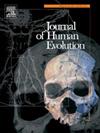Micro-computed tomography unveils anatomy of the oldest known plesiadapiform cranium
IF 3.1
1区 地球科学
Q1 ANTHROPOLOGY
引用次数: 0
Abstract
Palaechthonids are a likely paraphyletic or polyphyletic assemblage of dentally plesiomorphic plesiadapiforms known from the Paleocene of North America. This family is known primarily from isolated dental fossils, but one partial cranium of the palaechthonid Plesiolestes nacimienti (Division of Vertebrate Paleontology, Biodiversity Institute, University of Kansas [KUVP] 9557) exists and was studied a half-century ago to infer aspects of the paleobiology of basal or stem primates. Since then, additional plesiadapiform crania representing several families have been described, but KUVP 9557 remains the best preserved for a palaechthonid and is the geologically oldest known cranial fossil of any plesiadapiform or euarchontan mammal (primates + colugos + treeshrews). Here, for the first time, we scanned the partial cranium of P. nacimienti using micro-computed tomography (μCT) to assess previously described morphology, document novel morphology, and make comparisons with crania of other plesiadapiforms and euarchontans. While several previous cranial descriptions are reaffirmed here (e.g., caudal expansion of the nasals, an intraorbital lacrimal foramen), μCT scan data have clarified that certain previously identified structures (e.g., postorbital process) are not present and have unveiled previously unknown structures (e.g., foramen ovale, optic foramen). Comparisons indicate that the cranial anatomy of P. nacimienti is most like that of non-microsyopid plesiadapiforms and that unambiguous synapomorphies with an extant euarchontan clade are absent. Paleobiological inferences presented here suggest that P. nacimienti was broadly similar to the extant treeshrew Ptilocercus, albeit less insectivorous, which is in line with evolutionary scenarios proposed for the ancestral primatomorphan or the ancestral primate (sensu lato) that emphasize the importance of arboreality and angiosperm products.
微型计算机断层扫描揭示了已知最古老的蛇颈状头盖骨的解剖结构
古棘齿目动物是一种可能由牙齿似形蛇形适应动物组成的泛系或多系组合,已知于北美古新世。这个科主要是从孤立的牙齿化石中得知的,但古棘目Plesiolestes nacimienti(堪萨斯大学生物多样性研究所脊椎动物古生物学部[KUVP] 9557])的一个部分颅骨存在,并在半个世纪前进行了研究,以推断基础或主干灵长类动物的古生物学方面。从那时起,代表几个科的其他蛇颈类颅骨被描述,但KUVP 9557仍然是保存最完好的古蛇颈类,是地质上已知最古老的蛇颈类或原始哺乳动物(灵长类动物+鼯猴+树鼩)的颅骨化石。在这里,我们首次使用微计算机断层扫描(μCT)对P. nacimienti的部分颅骨进行了扫描,以评估先前描述的形态学,记录新的形态学,并与其他plesiadapiforms和euarchontans的颅骨进行了比较。虽然这里重申了先前的一些颅部描述(例如,鼻尾部扩张,眶内泪孔),但μCT扫描数据澄清了某些先前确定的结构(例如,眶后突)不存在,并且揭示了以前未知的结构(例如,卵圆孔,视神经孔)。比较表明,P. nacimienti的颅骨解剖结构最像非微颌类蛇的适应性,与现存的等颌类进化枝没有明确的突触形态。本文提出的古生物学推断表明,P. nacimienti与现存的树鼩Ptilocercus大致相似,尽管较少食虫,这与强调树栖和被子植物产物重要性的灵长类祖先或灵长类祖先(sensu lato)的进化情景一致。
本文章由计算机程序翻译,如有差异,请以英文原文为准。
求助全文
约1分钟内获得全文
求助全文
来源期刊

Journal of Human Evolution
生物-进化生物学
CiteScore
6.30
自引率
15.60%
发文量
104
审稿时长
3 months
期刊介绍:
The Journal of Human Evolution concentrates on publishing the highest quality papers covering all aspects of human evolution. The central focus is aimed jointly at paleoanthropological work, covering human and primate fossils, and at comparative studies of living species, including both morphological and molecular evidence. These include descriptions of new discoveries, interpretative analyses of new and previously described material, and assessments of the phylogeny and paleobiology of primate species. Submissions should address issues and questions of broad interest in paleoanthropology.
 求助内容:
求助内容: 应助结果提醒方式:
应助结果提醒方式:


